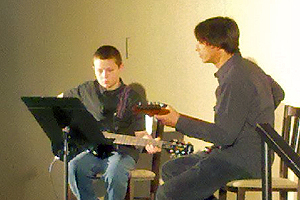The Circle of 5th’s
Thank you for stopping by to learn a little about music theory and the circle of 5th’s. Remember we offer a $10 introductory lesson at the Colorado School of Music. We teach a variety of instruments ranging from piano lessons, guitar lessons, vocal lessons, voice lessons, violin lessons, viola lessons, drum lessons, percussion lessons, ukulele lessons, trombone lessons, tuba lessons, euphonium and other orchestral instruments. We have students come from Denver, Lakewood, Arvada, Wheat Ridge, Morrison, Littleton, Golden and Evergreen. Contact us to come and try a lesson. www.coloradoschoolofmusic.com info@coloradoschoolofmusic.com or 303-526-9865
The Circle of 5th’s is the foundation for our western music system. I recommend either have a picture of the circle of 5th’s in front of you well reading this blog or if you want to click this link to a variety of picture of the circle of 5th’s here.
There are three main part to the circle of 5th’s. I am going to explain the circle in the simplest way I can and work from the outside of the circle in. The first thing we see on the outside of the circle is a picture of the treble clef and staff. If we look at the clef and staff that is at the top of the circle or where the number 12 would be on a clock we see there is nothing on the staff. This means there are no altered notes in this first key we are going to examine. Altered notes would be if we make a note flat or make a note sharp. This part of the circle of 5th’s is called the key signature portion of the circle. There is only this one position or key on the circle of 5th’s that does not have any flats or sharps. This position on the circle or key is the key of C major. We have not entered into part two of the three main parts of the circle of 5th’s. When I say this position of 12o’clock on the circle is the Key of C major I’m getting this information from the outside ring of the circle of 5th’s. If you look around at the outside ring of the circle going clock wise you will see keys in this order C,G,D,A,E,B,F#,C#. Each of these is it’s own major key. One of the reason the circle is called the circle of 5th’s is that as you move clock wise around the circle you will find each key is 5 up from the previous one. If we look at the Circle and go counter clock wise from C we see the keys of Bb,Eb,Ab,Db,Gb. All of the keys moving counter clock wise are flat keys, meaning they all have a flat. For example when I look at the very next key from C moving counter clock wise you see there is F. On the staff next the key of F you see one flat on the staff and that flat is Bb. This informs me that the key of F has one flat and that flat is Bb. The difference from the key of C to the key of F there is just one note that is altered which in turn makes this a new key the key of F.
Part three of the circle of 5th’s is the inner slices of the circle. Each inner slice of the circle relates to the outer ring of the circle. There relationship is call the relative minor key to the major key it matches up with in from the outer ring of the circle. C major is related to A minor or you could say the relative minor key to C major is A minor. The relative minor key is always six up from the major key. The reason the two keys are related is both of the related keys have the same notes and also the same chords in each key. The main difference of the relative keys is that they both have a different starting point. For example when we look at the key of C major the notes are C,D,E,F,G,A,B. When we look at the notes for the relative minor key to to C which is A minor the note are A,B,C,D,E,F,G. As you can see they both have the same notes but with different starting points. This rule follows for all of the keys in the Circle of 5th’s. I hope this has been helpful in understand the circle of 5th’s.
Please contact us to come in for your $10 introductory music lesson from one of our great instructors or myself to learn further about music education. We offer guitar lessons, piano lessons, drum lessons, violin lesson, Ukulele lessons, vocal lessons as wells as some orchestral instruments and more.
